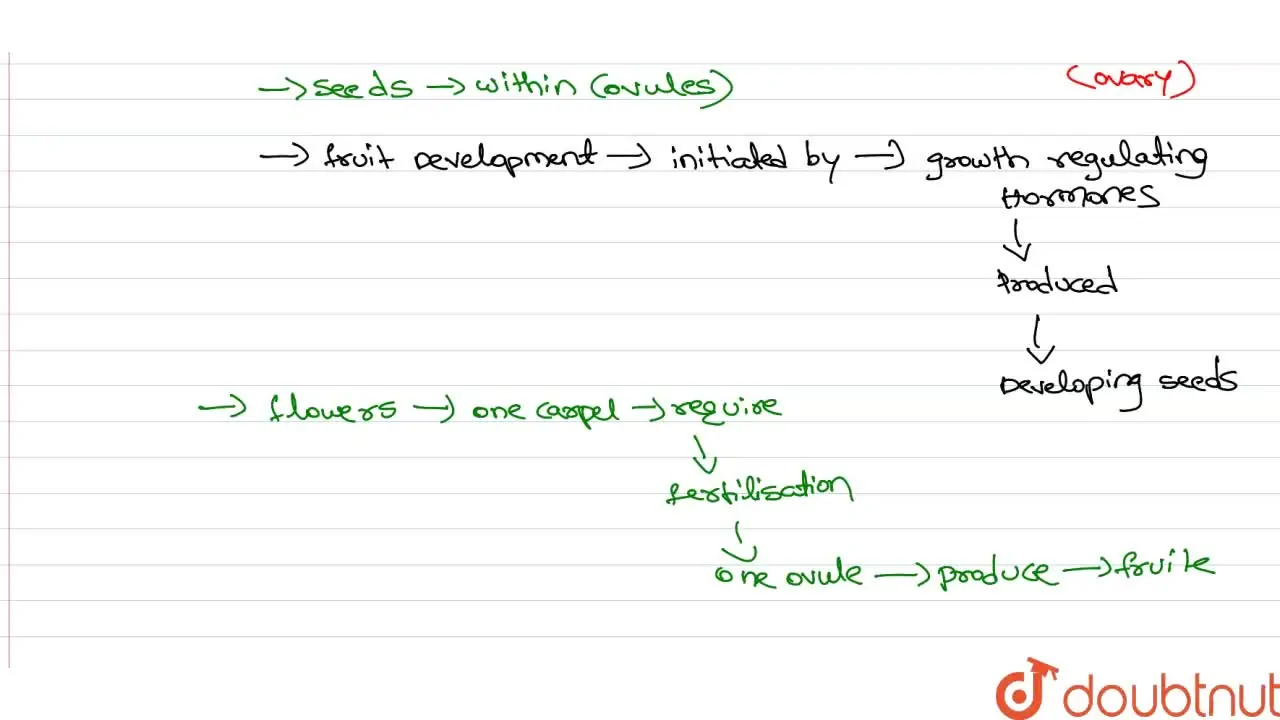Explain the formation of fruits and seeds in plants.Solution in Telugu
Process of double fertilization :
(1) At the time of fertilization there will be a totyal of 7 cells arranged in tree groups in a mature embryo sac.
(2) They are one egg (female gamet ) two synergids , one central cell ( secondary or polar nucleus ) and three antipodals.
(3) While all the cells are in haploid (n) codination only the polar nucleus is diploid (2n) . This is due to the fussion of two nuclei.
(4) The synergids are also known as helper calls .
(5) After pollination pollen grain recived by the stigma, germinate and give rise to pollen tubes. The pollen tube has two male nuclei.
(6) Usually the pollen tube enters the ovule through microphyle and discharges the two male gametes into the embryo sac .
(7) One male nucleus (gamet ) approaches the egg and fuses with it to form diploid (2n) zygote this is called first fertilization .
(8) The other male nucleus reaches the secondary nucleus (2n) (polar nucleus) and fuses with it to form endosperm nucleus which will be triploid . This is second fertilization. This double fertilization occurs in embryosac.
Changes after double fertilization :
(9) After double fertilization, the ovule increases in size rapidly as a result of formation of endosperm tissue by mitosis and the development of new embryo .
(10) The embryo consists of cotyledons an epicotyl and a hypocotyl . The cotyledons become grealty enlarged because of stored food for the seedling .
(11) The zygote divides several times to form an embryo within the ovule . The ovule develops a tough coat and is converted into a seed . The ovary grows to form a fruit.
Related Playlists
- BOOK - VGS PUBLICATION-BRILLIANTCHAPTER - REPRODUCTION THE GENERATING SYSTEMEXERCISE - CREATIVE QUESTIONS FOR NEW MODEL PAPER (2 MARK QUESTIONS)46videos
REPRODUCTION THE GENERATING SYSTEM
- BOOK - VGS PUBLICATION-BRILLIANTCHAPTER - REPRODUCTIONEXERCISE - EXERCISE347videos
REPRODUCTION
- BOOK - VGS PUBLICATION-BRILLIANTCHAPTER - RESPIRATIONEXERCISE - EXERCISE328videos
RESPIRATION
Similar Questions
Accourding to weismann prediction , every organism undergoes two kinds of cell divisions. In mitosis, there is no change in chromosomal number (2n) and in Meiosis, chromosomal number is reduced to half (n).
(ii) In which cells, Meiosis takes place ?02:14View SolutionDo you think reproduction occurs only for continuation of life ?
02:38View SolutionDistinguish between Inspiration and Expiration
02:01View SolutionThe plant, which has seeds but not fruits is
36:03View Solutionफल से अन्दर बीज उत्पन्न करने वाले पौधे है :
02:14View Solutionकुछ पौधों में निषेचन फल बनने के लिए आवश्यक घटना नहीं है। इस कथन की व्याख्या कीजिए।
03:09View SolutionPollination| Fertilisation| Fruit And Seed Formation
01:35View SolutionPlants that contain seeds but not fruits are -
06:27View SolutionGive significance of seed and fruit formation.
06:40View Solutionइनमें से किस पौधे में बीज होता है लेकिन फल नहीं ?
01:15View SolutionName a plant that forms seeds but no fruits.
01:32View SolutionTo which group does a pine tree belong? Explain the formation of the seeds in this plant.
02:14View SolutionMention significance of fruit and seed formation.
02:46View Solutionસપુષ્પ વનસ્પતિઓમાં ફલન વગર બીજનું નિર્માણ થવાની પ્રક્રિયામાં કઈ પ્રક્રિયા ભાગ લે છે ?
03:16View Solutionइनमें से किस पौधे में बीज होता है लेकिन फल नहीं?
02:08View SolutionExplain the formation of fruits and seeds in plants.
39:50View Solution


